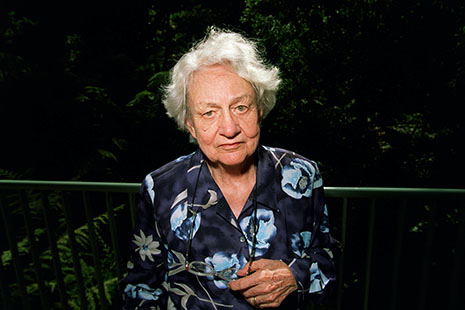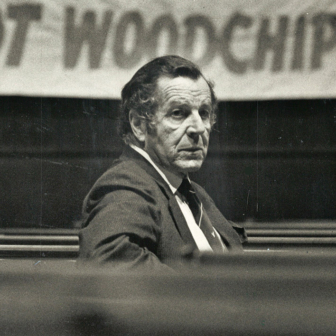THE main credits open onto an image of the planet, a curved section hanging in a dark sky, and for a second, the whole globe. Those shots will have delayed impact; at the end of the film, almost half an hour later, we’ll know why they’re there. Almost immediately then, we’re in the bush, in Kakadu, looking through the trees at a vast rock wall, while a woman’s voice – a friendly, humorous, matter-of-fact kind of voice – delivers a memory of time there. Nugget, says Meredith McKinney – meaning H.C. Coombs, widely known as Nugget – always wanted to show this place to her and to Judith Wright, his lover and Meredith’s mother. Judith is then quoted; she said, as Meredith remembers it, that the high wall with the ancient rock paintings was “far too sacred” a place for her; she would meet them at a bench along the path.
One of the many gifts of John Hughes’s short, lucid and wonderful film essay, Love and Fury (first seen last week in the ABC’s Artspace slot) is to give us back the wry and earthy Judith Wright, otherwise known as poet, conservationist and activist-visionary. Of her time driving round Central Australia in a red Mini Moke with Nugget, she could say “what fun!” and much later, toward the end of their days, could say again “it’s been fun!” Their best times, as Meredith remembers, were at Edge, her house near Braidwood; thinking, discussing, writing, always putting another log on the fire and drinking good red wine. Later, trying to cheer Nugget as he confronts the penalties of ageing, she thinks it’s not a bad idea to remain a little drunk. She is seen moving through the bush around “Edge,” furiously typing in her study in conscious, deliberate philosophic transit from the literary life to the political one, and telling the world in so many words that the wider battles – for Aboriginal rights and for the environment – are more important now than making poems. She says that the poems still visit, like butterflies fluttering around her; she turns them away.
For some in the literary world at that time, the 1980s, this was heresy; and that view – that art and politics are inherently at odds – is still lurking around. It is at the heart of cultural conservatism; and John Hughes’s film-making, from the 1970s to the present, confounds its proponents. His cinema is at once crowded, detailed, elegant and absolutely lucid; at the same time, it is shot through with political and historical understandings. In Love and Fury, the documentary sources are visible and palpable; Hughes finds the precise, dynamic angles for interviews so that information is always more than that, bringing close the minds, bodies and personalities that offer it. The principal witnesses to Wright and Coombs, with McKinney herself, are Fiona Capp, Nonie Sharp, Tim Rowse (Coombs’s biographer) and John Hawke, a scholar of Wright’s work. Each of these emerges as a character, present, fully believable, alive. Their evidence flows, along with the visible traces of the Coombs–Wright correspondence over twenty-five years, in written script and typescript.
“Documentary” is an inadequate term when the film’s logic involves the sight of a spider’s web, a blackbird on a bough, a flight of ducks over water in Kakadu, voices entering and receding with a popular love-song. The links are intuitive, subterranean – and submarine as well, when we come to Wright’s polemic for the Great Barrier Reef, The Coral Battleground. The argument, she said, must be felt as much as told; there’s a politics here all right, but no smear of moralism. Carried by her words in a late interview – “the world is such a bloody wonderful place” – the film brings us back to the planet. The impact from these eminent lovers’ shared values (and the profound ethical disconnect from those presently informing the polity) comes not as argument, but through a fusion of feeling, image, sound and vision. This is cinema.
AND SO, in an utterly different register, is the Chilean Pablo Larraín’s marvellously rambling essay No. This is the third of a trilogy centred on the Pinochet regime and its ending; it would be excellent to see the three in a row. Here Larraín’s strategy is to pull the audience back into the televisual milieu of the 1980s; the film is shot on video, a long-gone mode of video at that. The use of the old U-matic camera produces a shallow field of vision, constant blurring and blinding with shooting into the light, the main identities emerging bit by bit from general crowding and confusion. Much of what we see is archival television, and you’d say it hasn’t worn well if it were not that the film gains so much, as a treatment of history, from this immersion in the medium of its day. Some critics have been harsh on Larraín’s rough, lively stylistics; I think we get far more of that now-distant tumult through them than might have come out of a neatly costumed, tightly cast period-piece.
The fiction is sewn seamlessly into the archive. It gives us a young adman serving the No case in the 1988 referendum which, democratically, ended Pinochet’s cruelly anti-democratic rule; a win for Yes would have kept him in power for another eight years. René Saavedra (Gael García Bernal) persuades the No faction that peddling a list of the tyrant’s atrocities would be a losing strategy; the suffering population is now dangerously inured. He leaps smartly from soft-drink promotion (the fizz is called Free) into serious politics, while also juggling life as a single parent and ex-partner of a wild-haired radical named Veronica. He insists on lively, insouciant jingles, on song and dance, and slogans like “Happiness is on the way.” With the child in peril, he manages to dodge murderous pursuits by thugs on the other side. Some of this is history; the No vote won. In real life, however, there was more than one Saavedra; there were two leading activist admen in the No campaign, and a whole movement around them. Larraín concentrates the tensions; Saavedra’s boss at the agency, Guzmán (Alfredo Castro, in a subtle, compelling performance), is on Pinochet’s side. García Bernal, though rather too softly handsome, has a fine, steady way of staring through the mess and falsity around him.
There is high energy and elation in this version of the struggle; it summons up Brechtian tactics of defiant performance, resistant mockery in bad times. Perhaps there’s something here for those worthy, struggling militants who are now busy circulating the Institute of Public Affairs’s ominous program for the Coalition (scrap Medicare, trash public broadcasting, de-fund arts, sport and you-name-it): forget the gloom and doom, try well-scripted mockery with dancing in the streets, and keep it going relentlessly.





